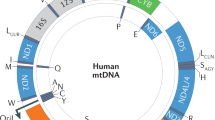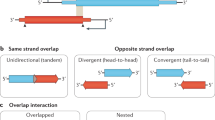Abstract
Engineered zinc-finger proteins (ZFPs) are hybrid proteins developed to direct various effector domains (EDs) of choice to predetermined DNA sequences. They are used to alter gene expression and to modify DNA in a sequence-specific manner in vivo and in vitro. Until now, ZFPs have mostly been used to target DNA sites in nuclear genomes. This protocol describes how to adapt engineered ZFP technology to specifically modify the mammalian mitochondrial genome. The first step describes how to construct mitochondrially targeted ZFPs (mtZFPs) so that they are efficiently imported into mammalian mitochondria. In the second step, methods to test the basic properties of mtZFPs in vitro are described. Finally, we outline how the mtZFPs can be transiently transfected into mammalian cells and their mitochondrial import tested by both immunofluorescence and biochemical methods. The protocol can be completed within a week, although time-consuming DNA cloning steps may extend this.
This is a preview of subscription content, access via your institution
Access options
Subscribe to this journal
Receive 12 print issues and online access
$259.00 per year
only $21.58 per issue
Buy this article
- Purchase on Springer Link
- Instant access to full article PDF
Prices may be subject to local taxes which are calculated during checkout






Similar content being viewed by others
References
Klug, A. The discovery of zinc fingers and their development for practical applications in gene regulation. Proc. Japan Acad. 81, 87–102 (2005).
Papworth, M., Kolasinska, P. & Minczuk, M. Designer zinc-finger proteins and their applications. Gene 366, 27–38 (2006).
Jamieson, A.C., Miller, J.C. & Pabo, C.O. Drug discovery with engineered zinc-finger proteins. Nat. Rev. Drug Discov. 2, 361–368 (2003).
Santiago, Y. et al. Targeted gene knockout in mammalian cells by using engineered zinc-finger nucleases. Proc. Natl. Acad. Sci. USA 105, 5809–5814 (2008).
Urnov, F.D. et al. Highly efficient endogenous human gene correction using designed zinc-finger nucleases. Nature 435, 646–651 (2005).
Moehle, E.A. et al. Targeted gene addition into a specified location in the human genome using designed zinc finger nucleases. Proc. Natl. Acad. Sci. USA 104, 3055–3060 (2007).
Geurts, A.M. et al. Knockout rats via embryo microinjection of zinc-finger nucleases. Science 325, 433 (2009).
Doyon, Y. et al. Heritable targeted gene disruption in zebrafish using designed zinc-finger nucleases. Nat. Biotechnol. 26, 702–708 (2008).
Meng, X., Noyes, M.B., Zhu, L.J., Lawson, N.D. & Wolfe, S.A. Targeted gene inactivation in zebrafish using engineered zinc-finger nucleases. Nat. Biotechnol. 26, 695–701 (2008).
Foley, J.E. et al. Rapid mutation of endogenous zebrafish genes using zinc finger nucleases made by Oligomerized Pool ENgineering (OPEN). PLoS One 4, e4348 (2009).
Kim, Y.G., Cha, J. & Chandrasegaran, S. Hybrid restriction enzymes: zinc finger fusions to Fok I cleavage domain. Proc. Natl. Acad. Sci. USA 93, 1156–1160 (1996).
Kandavelou, K. et al. Targeted manipulation of mammalian genomes using designed zinc finger nucleases. Biochem. Biophys. Res. Commun. 388, 56–61 (2009).
Taylor, R.W. & Turnbull, D.M. Mitochondrial DNA mutations in human disease. Nat. Rev. Genet. 6, 389–402 (2005).
Schapira, A.H. Mitochondrial disease. Lancet 368, 70–82 (2006).
Minczuk, M., Papworth, M.A., Kolasinska, P., Murphy, M.P. & Klug, A. Sequence-specific modification of mitochondrial DNA using a chimeric zinc finger methylase. Proc. Natl. Acad. Sci. USA 103, 19689–19694 (2006).
Taylor, R.W., Chinnery, P.F., Turnbull, D.M. & Lightowlers, R.N. Selective inhibition of mutant human mitochondrial DNA replication in vitro by peptide nucleic acids. Nat. Genet. 15, 212–215 (1997).
Tanaka, M. et al. Gene therapy for mitochondrial disease by delivering restriction endonuclease SmaI into mitochondria. J. Biomed. Sci. 9, 534–541 (2002).
Alexeyev, M.F. et al. Selective elimination of mutant mitochondrial genomes as therapeutic strategy for the treatment of NARP and MILS syndromes. Gene Ther. 15, 516–523 (2008).
Minczuk, M., Papworth, M.A., Miller, J.C., Murphy, M.P. & Klug, A. Development of a single-chain, quasi-dimeric zinc-finger nuclease for the selective degradation of mutated human mitochondrial DNA. Nucleic Acids Res. 36, 3926–3938 (2008).
Papworth, M. et al. Inhibition of herpes simplex virus 1 gene expression by designer zinc-finger transcription factors. Proc. Natl. Acad. Sci. USA 100, 1621–1626 (2003).
Cornu, T.I. et al. DNA-binding specificity is a major determinant of the activity and toxicity of zinc-finger nucleases. Mol. Ther. 16, 352–358 (2008).
Carroll, D., Morton, J.J., Beumer, K.J. & Segal, D.J. Design, construction and in vitro testing of zinc finger nucleases. Nat. Protoc. 1, 1329–1341 (2006).
Wright, D.A. et al. Standardized reagents and protocols for engineering zinc finger nucleases by modular assembly. Nat. Protoc. 1, 1637–1652 (2006).
Sander, J.D., Zaback, P., Joung, J.K., Voytas, D.F. & Dobbs, D. An affinity-based scoring scheme for predicting DNA-binding activities of modularly assembled zinc-finger proteins. Nucleic Acids Res. 37, 506–515 (2009).
Fu, F. et al. Zinc Finger Database (ZiFDB): a repository for information on C2H2 zinc fingers and engineered zinc-finger arrays. Nucleic Acids Res. 37, D279–D283 (2009).
Maeder, M.L. et al. Rapid 'open-source' engineering of customized zinc-finger nucleases for highly efficient gene modification. Mol. Cell 31, 294–301 (2008).
Sander, J.D., Zaback, P., Joung, J.K., Voytas, D.F. & Dobbs, D. Zinc Finger Targeter (ZiFiT): an engineered zinc finger/target site design tool. Nucleic Acids Res. 35, W599–W605 (2007).
Pfanner, N. & Geissler, A. Versatility of the mitochondrial protein import machinery. Nat. Rev. Mol. Cell Biol. 2, 339–349 (2001).
Fernandez-Martinez, J. et al. Overlap of nuclear localisation signal and specific DNA-binding residues within the zinc finger domain of PacC. J. Mol. Biol. 334, 667–684 (2003).
Matheny, C., Day, M.L. & Milbrandt, J. The nuclear localization signal of NGFI-A is located within the zinc finger DNA binding domain. J. Biol. Chem. 269, 8176–8181 (1994).
Gaines, G.L. III . In organello RNA synthesis system from HeLa cells. Methods Enzymol. 264, 43–49 (1996).
Leister, D. & Herrmann, J.M. Mitochondria Practical Protocols (Humana Press, Totowa, 2007).
Copeland, W.C. Mitochondrial DNA (Humana Press, Totowa, 2002).
Hartmann, C.M., Gehring, H. & Christen, P. The mature form of imported mitochondrial proteins undergoes conformational changes upon binding to isolated mitochondria. Eur. J. Biochem. 218, 905–910 (1993).
Taylor, S.W. et al. Characterization of the human heart mitochondrial proteome. Nat. Biotechnol. 21, 281–286 (2003).
D'Errico, I., Dinardo, M.M., Capozzi, O., De Virgilio, C. & Gadaleta, G. History of the Tfam gene in primates. Gene 362, 125–132 (2005).
Acknowledgements
This work was supported by the Medical Research Council, UK and the Federation of European Biochemical Societies Long-Term Fellowship (M.M.) and Federation of European Biochemical Societies Short-Term Fellowship (P.K.-Z.). We thank M. Moore, Mark I. and Y. Choo for their contribution in developing the presented methods. We are grateful to Sangamo Biosciences for providing us with many of the mtDNA-specific zinc-finger peptides that were used in the development of the presented protocols. We also thank Joanna Rorbach for her help on the manuscript.
Author information
Authors and Affiliations
Contributions
M.M., M.A.P and M.P.M. designed the research; M.M., M.A.P. and P.K.-Z. carried out the experiments; M.M., M.A.P., P.K.-Z. and M.P.M. analyzed data; and M.M., M.A.P. and M.P.M. wrote the paper.
Corresponding author
Ethics declarations
Competing interests
The authors declare no competing financial interests.
Supplementary information
Supplementary Figure 1
(a) DNA cloning strategy as described in Steps 1-5 of the main text. The MTS from the File subunit of the human mitochondrial ATP synthase is indicated in red, the NES from the NS2 protein of MVM is indicated in yellow. Exemplary ZFP21 (Minczuk et al., 2006) cloned between the MTS and NES is indicated in cyan and the HA epitope tag is in green. (b) DNA and protein sequence of the mtZFP insert constructed according to the description of Steps 1-5 and illustrated in (a). (PDF 58 kb)
Supplementary Fig. 2
An illustration of a small-scale “homogeniser” constructed by inserting of a plunger of 1 ml syringe (with a rubber tip) into a standard 1.5 ml eppendorf tube. By moving the plunger up and down suction force is created that efficiently disrupts cells. We have tested other small-scale homogenisers e.g. 0.1 ml homogeniser mortar (Fisher Scientific, cat. no. FB56673) or motor driven pellet pestle (Cordless motor, SIGMA cat. no. Z359971 with 1.5 polypropylene pellet pestle (SIGMA cat. no. Z359947), however, our “home-made” plunger-eppendorf tube homogeniser gave the most efficient cell disruption in the presented mitochondria isolation protocol. (PDF 33 kb)
Rights and permissions
About this article
Cite this article
Minczuk, M., Kolasinska-Zwierz, P., Murphy, M. et al. Construction and testing of engineered zinc-finger proteins for sequence-specific modification of mtDNA. Nat Protoc 5, 342–356 (2010). https://doi.org/10.1038/nprot.2009.245
Published:
Issue Date:
DOI: https://doi.org/10.1038/nprot.2009.245
This article is cited by
-
Trends and prospects in mitochondrial genome editing
Experimental & Molecular Medicine (2023)
-
A library of base editors for the precise ablation of all protein-coding genes in the mouse mitochondrial genome
Nature Biomedical Engineering (2022)
-
In vivo mitochondrial base editing via adeno-associated viral delivery to mouse post-mitotic tissue
Nature Communications (2022)
-
Site-specific CRISPR-based mitochondrial DNA manipulation is limited by gRNA import
Scientific Reports (2022)
-
Genome editing in mitochondria corrects a pathogenic mtDNA mutation in vivo
Nature Medicine (2018)
Comments
By submitting a comment you agree to abide by our Terms and Community Guidelines. If you find something abusive or that does not comply with our terms or guidelines please flag it as inappropriate.



